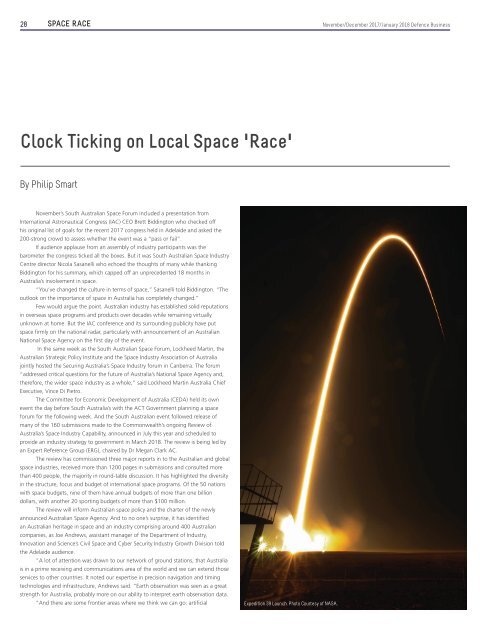Defence Business Issue 41
You also want an ePaper? Increase the reach of your titles
YUMPU automatically turns print PDFs into web optimized ePapers that Google loves.
28 SPACE RACE<br />
November/December 2017/January 2018 <strong>Defence</strong> <strong>Business</strong><br />
Clock Ticking on Local Space 'Race'<br />
By Philip Smart<br />
November’s South Australian Space Forum included a presentation from<br />
International Astronautical Congress (IAC) CEO Brett Biddington who checked off<br />
his original list of goals for the recent 2017 congress held in Adelaide and asked the<br />
200-strong crowd to assess whether the event was a “pass or fail”.<br />
If audience applause from an assembly of industry participants was the<br />
barometer the congress ticked all the boxes. But it was South Australian Space Industry<br />
Centre director Nicola Sasanelli who echoed the thoughts of many while thanking<br />
Biddington for his summary, which capped off an unprecedented 18 months in<br />
Australia’s involvement in space.<br />
“You’ve changed the culture in terms of space,” Sasanelli told Biddington. “The<br />
outlook on the importance of space in Australia has completely changed.”<br />
Few would argue the point. Australian industry has established solid reputations<br />
in overseas space programs and products over decades while remaining virtually<br />
unknown at home. But the IAC conference and its surrounding publicity have put<br />
space firmly on the national radar, particularly with announcement of an Australian<br />
National Space Agency on the first day of the event.<br />
In the same week as the South Australian Space Forum, Lockheed Martin, the<br />
Australian Strategic Policy Institute and the Space Industry Association of Australia<br />
jointly hosted the Securing Australia’s Space Industry forum in Canberra. The forum<br />
“addressed critical questions for the future of Australia’s National Space Agency and,<br />
therefore, the wider space industry as a whole,” said Lockheed Martin Australia Chief<br />
Executive, Vince Di Pietro.<br />
The Committee for Economic Development of Australia (CEDA) held its own<br />
event the day before South Australia’s with the ACT Government planning a space<br />
forum for the following week. And the South Australian event followed release of<br />
many of the 160 submissions made to the Commonwealth’s ongoing Review of<br />
Australia’s Space Industry Capability, announced in July this year and scheduled to<br />
provide an industry strategy to government in March 2018. The review is being led by<br />
an Expert Reference Group (ERG), chaired by Dr Megan Clark AC.<br />
The review has commissioned three major reports in to the Australian and global<br />
space industries, received more than 1200 pages in submissions and consulted more<br />
than 400 people, the majority in round-table discussion. It has highlighted the diversity<br />
in the structure, focus and budget of international space programs. Of the 50 nations<br />
with space budgets, nine of them have annual budgets of more than one billion<br />
dollars, with another 20 sporting budgets of more than $100 million.<br />
The review will inform Australian space policy and the charter of the newly<br />
announced Australian Space Agency. And to no one’s surprise, it has identified<br />
an Australian heritage in space and an industry comprising around 400 Australian<br />
companies, as Joe Andrews, assistant manager of the Department of Industry,<br />
Innovation and Science’s Civil Space and Cyber Security Industry Growth Division told<br />
the Adelaide audience.<br />
“A lot of attention was drawn to our network of ground stations, that Australia<br />
is in a prime receiving and communications area of the world and we can extend those<br />
services to other countries. It noted our expertise in precision navigation and timing<br />
technologies and infrastructure, Andrews said. “Earth observation was seen as a great<br />
strength for Australia, probably more on our ability to interpret earth observation data.<br />
“And there are some frontier areas where we think we can go: artificial<br />
Expedition 39 Launch. Photo Courtesy of NASA.


















